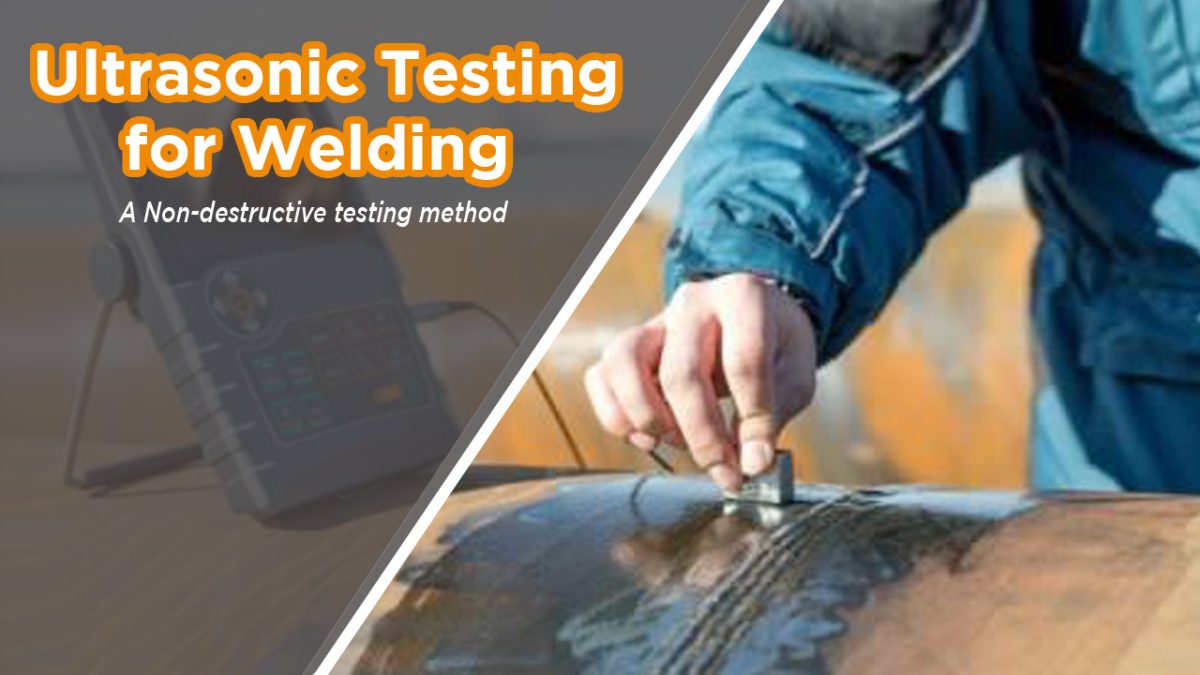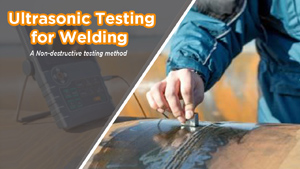Welding is a critical process in various industries, including construction, manufacturing, and engineering. It involves joining two or more metal components together to create a strong and durable bond. However, ensuring the quality and safety of welds is of utmost importance to avoid structural failures and potential hazards. This is where ultrasonic inspection plays a vital role. Ultrasonic test for welding utilizes high-frequency sound waves to detect and evaluate defects or discontinuities within welds, ensuring their integrity and reliability.
Ultrasonic inspection involves the use of specialized equipment, such as ultrasonic testing machines and transducers. These machines emit ultrasonic waves into the weld area, and the waves bounce back differently depending on the presence of defects or abnormalities. By analyzing the reflected waves, inspectors can identify and assess various types of flaws, such as cracks, porosity, lack of fusion, and incomplete penetration. This non-destructive testing method provides valuable insights into the quality of welds and helps prevent catastrophic failures.

Image by inspection-for-industry
Role of ultrasonic test in welding for ensuring the quality
Quality control is paramount in welding to guarantee the structural integrity of welded components. Even the smallest defects in welds can compromise their strength and performance. Ultrasonic inspection plays a crucial role in ensuring welding quality by detecting and evaluating these defects with precision. By conducting ultrasonic test during and after the welding process, inspectors can identify any flaws that may affect the weld’s strength, durability, and overall quality.
Ultrasonic testing can detect defects that may not be visible to the naked eye or even through other non-destructive testing methods. This makes it a valuable tool in assessing the internal soundness of welds. Inspectors can perform thorough examinations of welds, checking for the presence of cracks, inclusions, or other anomalies that can compromise the weld’s performance. Early detection of these defects allows for timely corrections or repairs, ensuring that the final welded product meets the required quality standards.
Furthermore, ultrasonic test provides quantitative data that allows for the precise characterization of defects within welds. By analyzing the size, shape, and location of flaws, inspectors can determine their severity and assess the potential impact on the welded structure’s strength. This valuable information helps engineers and welders make informed decisions about the acceptability and reparability of welds, preventing costly rework and ensuring the highest level of quality in welding processes.
Importance of ultrasonic testing of welds safety
Safety is a paramount concern in welding, as defective welds can lead to catastrophic failures and put lives at risk. Ultrasonic test plays a crucial role in ensuring welding safety by detecting and assessing defects that may compromise the structural integrity of welds. By identifying potential flaws early on, ultrasonic test allows for timely corrective actions, reducing the risk of weld failures and associated hazards.
Defects such as cracks or lack of fusion in welds can significantly weaken the joint and make it susceptible to failure under applied loads or environmental conditions. By utilizing ultrasonic testing, inspectors can accurately locate and evaluate these defects, providing valuable insights into their size, shape, and potential impact on weld strength. This information enables engineers and welders to make informed decisions regarding the safety of the weld and take appropriate measures to address any identified issues.
Moreover, ultrasonic test can help identify defects that may not be visible on the surface of the weld, ensuring the detection of internal flaws that could compromise safety. Hidden defects, such as porosity or incomplete penetration, can weaken the weld and lead to catastrophic failures. By utilizing ultrasonic testing techniques, inspectors can thoroughly examine the internal structure of welds, mitigating the risk of undetected defects and ensuring the safety of welded components.
How does Ultrasonic Testing Work?
Ultrasonic inspection in welding relies on the principles of sound wave propagation and reflection. During the inspection process, an ultrasonic testing machine emits high-frequency sound waves into the weld area. These waves travel through the material until they encounter a boundary or an internal defect within the weld.
When the sound waves encounter a boundary, such as the interface between two materials or the surface of a defect, a portion of the wave is reflected back towards the transducer. The reflected waves are then detected by the transducer and converted into electrical signals. By analyzing the characteristics of these signals, inspectors can determine the presence, location, and size of defects within the weld.
The ability of ultrasonic waves to penetrate deep into the material makes them ideal for inspecting welds. The waves can travel through different types of metals, including steel, aluminum, and titanium, providing a comprehensive evaluation of the weld’s internal structure. The use of different probe frequencies allows for the inspection of various weld thicknesses, ensuring the suitability of ultrasonic inspection for a wide range of welding applications.
Advantages of ultrasonic testing in welding
Ultrasonic testing offers numerous advantages over other non-destructive testing methods in welding. One of the key benefits is its ability to detect and evaluate internal defects within welds, which may not be visible through visual inspection or other surface-based techniques. This allows for a more comprehensive assessment of the weld’s quality and integrity.
Another advantage of ultrasonic testing is its ability to provide quantitative data about the size, shape, and location of defects. This information enables engineers and welders to make informed decisions regarding the acceptability and reparability of welds. By having precise measurements of defects, they can assess the impact on the weld’s strength and determine the necessary corrective actions.
Ultrasonic testing is a non-destructive testing method, meaning it does not cause any damage to the weld or the surrounding material. This is particularly important in cases where the welded components are critical or expensive. By using ultrasonic testing, inspectors can evaluate the quality of welds without compromising their structural integrity, ensuring the reliability and longevity of the finished product.
Applications of ultrasonic testing in welding
Ultrasonic testing finds widespread applications in various industries where welding is a critical process. One common application is in the construction industry, where ultrasonic testing is used to assess the quality and integrity of welded structural components, such as bridges, buildings, and pipelines. By conducting ultrasonic testing, engineers can ensure that the welds meet the required standards and can withstand the applied loads and environmental conditions.
Another important application of ultrasonic testing is in the manufacturing of pressure vessels and storage tanks. These components are subjected to high internal pressures, making the quality of welds crucial for their safety and performance. Ultrasonic testing allows for thorough examinations of welds, ensuring the absence of defects that could compromise the structural integrity of these critical components.
Ultrasonic testing is also commonly used in the aerospace industry, where weld quality is of utmost importance. Welded components in aircraft, such as fuselages and engine parts, undergo rigorous inspections to ensure maximum safety and reliability. Ultrasonic testing techniques play a vital role in detecting and evaluating defects within these welds, enabling engineers to make informed decisions about their acceptability and reparability.
Challenges and limitations of ultrasonic testing of welds
While ultrasonic testing is a valuable tool in ensuring welding quality and safety, it does have certain challenges and limitations. One of the main challenges is the need for skilled and trained inspectors. Interpreting the ultrasonic signals and accurately identifying defects require expertise and experience. Improper interpretation can lead to false-positive or false-negative results, compromising the reliability of the inspection. Therefore, it is crucial to have well-trained inspectors who understand the principles and limitations of ultrasonic inspection in welding.
Another challenge is the influence of surface conditions on the ultrasonic signals. Surface roughness, coatings, and other contaminants can affect the accuracy and reliability of the inspection results. Proper surface preparation, including cleaning and removing coatings, is essential to ensure the effectiveness of ultrasonic inspection in welds.
Additionally, ultrasonic testing may have limitations in inspecting certain types of welds or materials. For example, highly attenuating materials or thick sections may require specialized techniques or equipment to overcome signal loss or distortion. The ability to inspect complex geometries or hard-to-reach areas may also be limited, requiring alternative testing methods to complement ultrasonic testing .
Best practices for performing ultrasonic testing of welds
To ensure the effectiveness and reliability of ultrasonic inspection in welding, certain best practices should be followed. Firstly, proper calibration of the ultrasonic testing equipment is essential. This involves verifying the accuracy of the equipment and adjusting the settings to ensure reliable and accurate results. Regular calibration checks should be performed to maintain the equipment’s performance.
Secondly, surface preparation is crucial for accurate ultrasonic testing. The weld surface should be clean, free from coatings, and properly prepared to provide optimal ultrasonic wave propagation. Surface contaminants or roughness can affect the accuracy of the inspection results and should be carefully addressed before conducting the inspection.
Furthermore, proper coupling between the ultrasonic transducer and the weld surface is essential. A suitable couplant, such as a gel or oil, should be used to ensure good acoustic contact and efficient transmission of ultrasonic waves into the weld. This helps minimize signal loss and ensures accurate detection of defects.
In addition, regular training and qualification of inspectors are necessary to maintain the quality and reliability of ultrasonic testing for welding. Inspectors should be knowledgeable about the principles, techniques, and limitations of ultrasonic testing. They should also stay updated with the latest advancements and industry standards to ensure their skills are up to date.
Conclusion and the future of ultrasonic testing of welds
Ultrasonic testing has become an indispensable tool in ensuring the quality and safety of welds. Its ability to detect and assess internal defects within welds provides valuable insights into their integrity and performance. By utilizing ultrasonic testing techniques, engineers and welders can make informed decisions about the acceptability and reparability of welds, preventing catastrophic failures and ensuring the highest level of quality in welding processes.
As technology continues to advance, the future of ultrasonic testing of welds holds great promise. The development of more advanced and sophisticated ultrasonic testing equipment will further enhance the accuracy and reliability of inspections. Additionally, the integration of artificial intelligence and machine learning algorithms may enable automated defect recognition and analysis, streamlining the inspection process and improving efficiency.
In conclusion, ultrasonic testing for welding is a vital component of quality control and safety assurance. Its ability to detect and evaluate defects within welds plays a crucial role in ensuring the reliability and integrity of welded structures. By adhering to best practices and embracing technological advancements, the future of ultrasonic testing for welding looks promising, paving the way for safer and higher quality welds.
